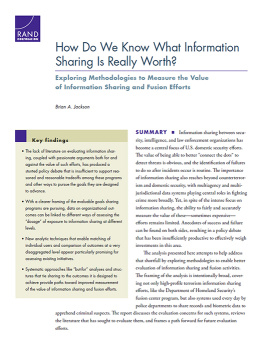STRENGTHENING CHILD PROTECTION
Sharing information in multi-agency settings
Kellie Thompson
First published in Great Britain in 2016 by
Policy Press University of Bristol 1-9 Old Park Hill Bristol BS2 8BB UK Tel +44 (0)117 954 5940 e-mail
North American office: Policy Press c/o The University of Chicago Press 1427 East 60th Street Chicago, IL 60637, USA t: +1 773 702 7700 f: +1 773-702-9756 e:
Policy Press 2016
British Library Cataloguing in Publication Data
A catalogue record for this book is available from the British Library.
Library of Congress Cataloging-in-Publication Data
A catalog record for this book has been requested.
ISBN 978-1-4473-2251-1 paperback
ISBN 978-1-4473-2253-5 ePub
ISBN 978-1-4473-2254-2 Mobi
The right of Kellie Thompson to be identified as author of this work has been asserted by her in accordance with the Copyright, Designs and Patents Act 1988.
All rights reserved: no part of this publication may be reproduced, stored in a retrieval system, or transmitted in any form or by any means, electronic, mechanical, photocopying, recording, or otherwise without the prior permission of Policy Press.
The statements and opinions contained within this publication are solely those of the author and not of the University of Bristol or Policy Press. The University of Bristol and Policy Press disclaim responsibility for any injury to persons or property resulting from any material published in this publication.
Policy Press works to counter discrimination on grounds of gender, race, disability, age and sexuality.
Cover design by Double Dagger
Front cover: image kindly supplied by Getty
Readers Guide
This book has been optimised for PDA.
Tables may have been presented to accommodate this devices limitations.
Image presentation is limited by this devices limitations.
In memoriam
Mary Rose Goodwin (ne Didd) (19342008)
Wesley John Goodwin (19322009)
To
Tamara, Saskia, and Mum love and thanks for many different reasons.
Contents
List of figures and tables
Figures
| 2.1 | Information sharing: advice for practitioners providing safeguarding services to children, young people, parents and carers |
| 4.1 | Wilsons original model of information behaviour (1981) |
| 4.2 | Flowchart of inter-professional information behaviour adapted from Wilsons (1996) model of information behaviour |
| 4.3 | A police officers information needs and behaviour |
Table
| 6.1 | The jigsaw in the diagnosis of neglect |
Acknowledgements
I would like to express my sincere thanks to all those that have contributed to the development of the ideas explored in this book, namely Professor Corinne May-Chahal, Professor Karen Broadhurst, Dr Paula Doherty and Dr Emma Vickers, and to all the professionals for the valuable contributions that formed the foundations of this book; without their time, patience, honesty and willingness to talk about, and debate, the issues raised, this book would never have happened. I would also like to thank Paul Thompson, my family and friends, and treasured colleagues at the University of Bedfordshire who have offered invaluable advice and support over many years. Last, but by no means least, I would like to extend my sincere gratitude to Professor Sue White not only for taking the time to read this book and write the foreword, but also for the consistent support she has given me in my role as an early career academic.
Foreword
This book addresses a recurrent theme in the reporting of, and responses to, child protection tragedies in the UK and internationally. When systems fail and professional judgements retrospectively prove to be wrong, shrill exhortations for professionals to share information to facilitate better multi-agency working are once again recharged and the volume cranked up. This book provides a welcome analysis of why information sharing remains a wicked issue.
Research, including my own, shows that knowledge sharing and learning are influenced by multiple interpersonal, social and organisational factors. The identification of children at risk and the sharing of knowledge and decision making across time and space may properly be conceived as a complex system, whereby inter-dependencies and couplings between professionals and agencies can be both the source of safety but also a risk, depending on how they are done. The promotion of multi-agency working with children and families is promoted as a way to prevent children slipping through the net of services, and of ensuring that professionals have the full picture. The literature repeatedly emphasises that good communication has the potential to reduce this complexity and support coordination, but what does communication mean and how does one know when it has taken place?
Knowledge sharing is more than the transmission of information. It denotes the exchange and use of diverse knowledge, and often more tacit know-how, between different groups to engender shared understanding. But, as this book shows, knowledge is difficult to share and it typically acquired and developed through participation in communities of practice, rather than management information systems. In short, knowledge is not a thing that a community has, but rather it is what they do, make and who they are. This distinction is important because efforts to understand, and indeed promote knowledge sharing and collaboration, should focus not only on the formal assemblages of knowledge, but also the more informal and unarticulated manifestations of knowhow. Recognising these differences, knowledge sharing requires different strategies and practices. The sharing of tacit knowledge is often based on more informal, day-to-day interactions around common problems, the creation of opportunities to enable social intercourse and creative problem solving. The detailed empirical work in this book shows how professional sense making is constrained by the local organisational practices that disrupt relationships and reduce or eliminate proximity.
Child welfare services are caught in a perpetual tension between the rights of the many to help and freedom from unwelcome scrutiny and intrusive intervention into the intimate spaces of family life and those of the relatively few who come to serious harm. The precautionary principle is constantly in a dance with proportionality. The policy response to high-profile events has been to standardise processes and seek consistent thresholds. This, it has been argued, would ensure safety in the system. In fact, it has led to a great deal of screening behaviour and short-term, multiple assessments in childrens services often at the expense of practical help and sustained relational support. Services become increasingly distanced from families, communities and from each other. Technology is held up as the solution to this distance it can facilitate efficient information sharing and timely responses across time and space.
This book shows us why this is not so simple. For example, attempts to manage risk in the multi-agency system and encourage a referring culture can have the unintended consequence of swamping childrens social care. This leads to gatekeeping practices to manage demand, which in turn can spawn precipitous reorganisation and instability. Meanwhile, other agencies feel they are left holding unacceptable levels of risk and thus they are compelled to refer. Professionals and their managers have been caught in a sea of contradictory imperatives and attempts to manage complexity have too often led to complicated structures, systems and sign-offs and an attempt to slice practice into simple chunks.









